The Samsung 950 Pro PCIe SSD Review (256GB and 512GB)
by Billy Tallis on October 22, 2015 10:55 AM ESTSequential Write Performance
The sequential write test isn't limited to a small span of the disk, as that usually doesn't make a difference for this performance metric. As always, our averages are of the lower queue depths, but scaling to higher queue depths is also investigated. Bulk file copies and recording uncompressed video are the kind of uses that depend on sequential write performance.
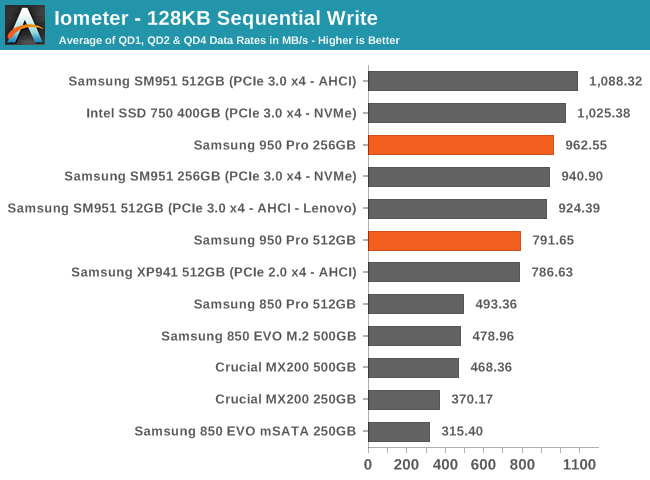
Even at low queue depths, most SSDs can spread a sequential write workload across multiple channels to achieve very high throughput. All of the PCIe drives perform well above the SATA limit but nowhere near the capacity of the PCIe links. The 512GB 950 Pro seems to again be encountering thermal throttling, and more severely than the SM951s we tested.
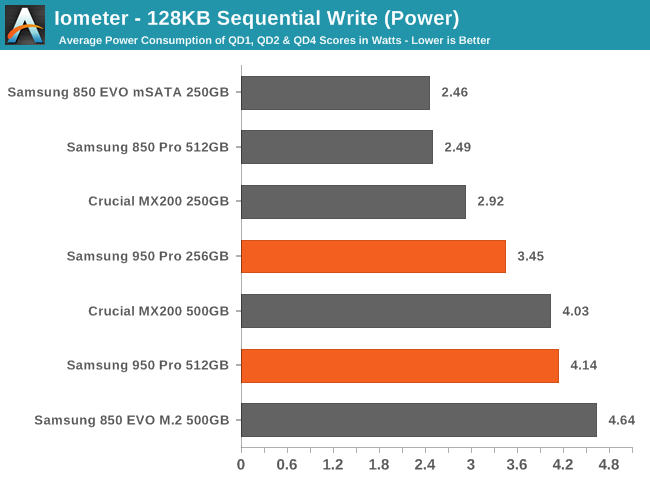
The average power consumption for writes is still on the high side by SATA standards, but is quite reasonable in light of the performance achieved.
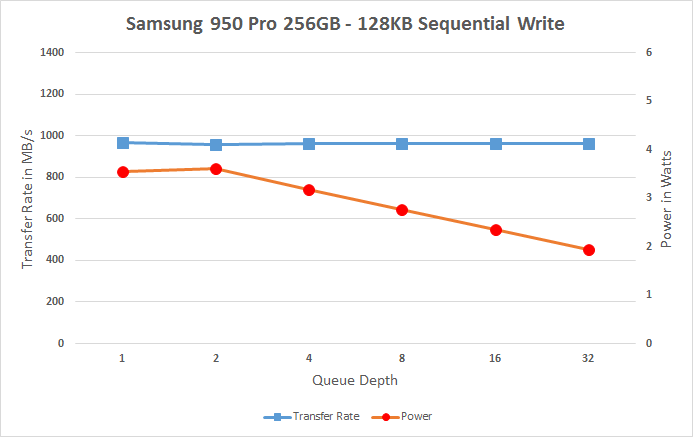 |
|||||||||
Performance across the sequential write test is mostly constant, but power isn't. The declines in power consumption in spite of increased queue depth are again most likely an artifact of whatever background processing is going on in the drive. On SATA drives, it's usually obvious from looking at the power meter when a drive has completed background processing and is truly idle and ready to run the next test, but with the lack of working power management for PCIe drives on our testbed I'm not so sure here. Overall it's probably a good sign that the drives were able to maintain high performance in spite of whatever else was going on, but given more cooling the 512GB can probably do much better.
Sequential Read Performance
Just like the random read test, sequential reads are tested across the span of a full drive and a representative sample of queue depths. Most operations involving large files (typically images and videos) fall under this test's purveiw, but streaming or playing even the highest resolution videos won't be a challenge for any of these drives. Copying files to another SSD or loading a new level in a video game would be more likely to show noticeable difference from better performance here.
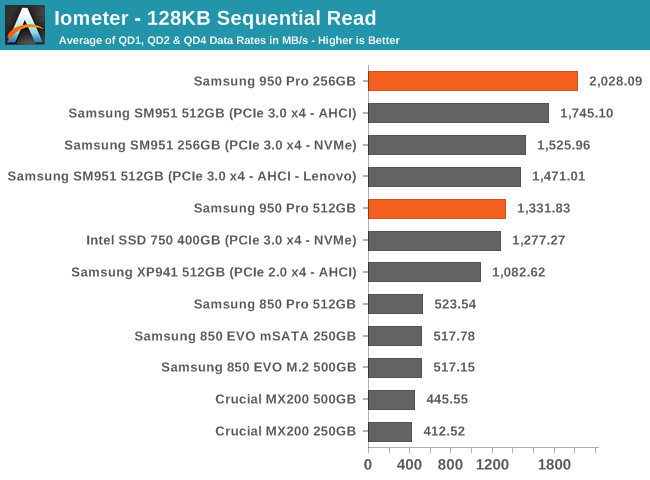
The sequential read performance is probably the best showcase of what the PCIe 3.0 x4 interface can do. The 256GB 950 Pro attains over half of the link speed, but the 512GB is again bogged down by something—relatively speaking, since it's still more than twice the speed of SATA and faster than even the Intel SSD 750. It's possible that the 950 Pro isn't faithfully implementing the secure form of the NVMe format command and some lingering fragmentation is preventing the 512GB drive from performing as specified. Read operations require less power to be supplied to the flash chip than for writes, but if the thermal throttling is all in the controller it could be showing up here as well.
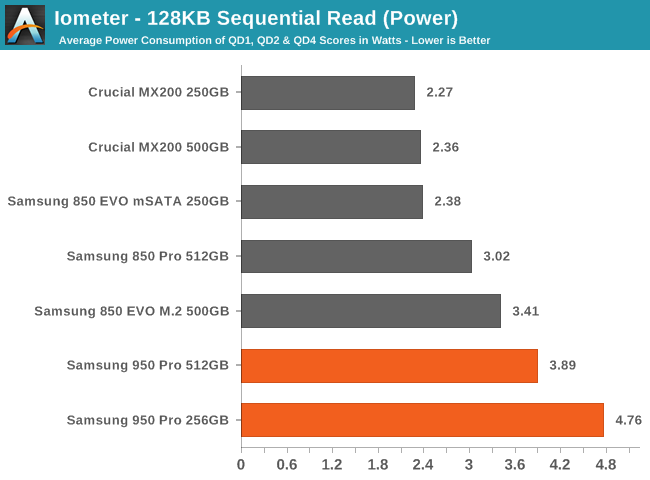
Relative to each other, the 950 Pro's power consumption is in line with the performance they're demonstrating, and proportionally much better than the SATA drives.
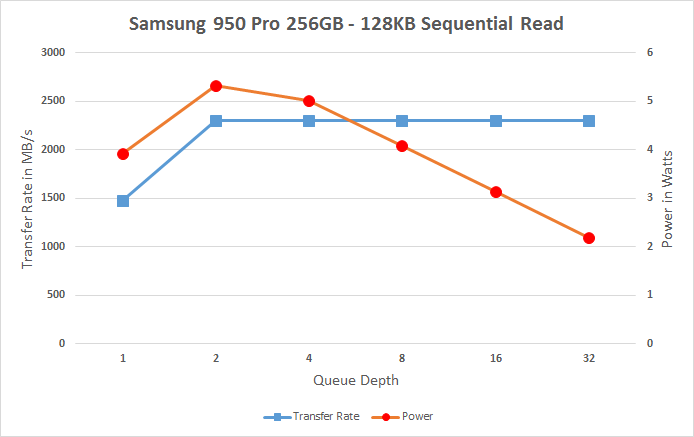 |
|||||||||
At queue depth 1, both of the 950 drives are performing similarly. When moving to higher queue depths the 256GB immediately hits 104% of its rated speed, but the 512GB doesn't improve any. (It's worth noting the differing scale for Transfer Rate in the graphs above.) The puzzling decline in power consumption at higher queue depths shows up again on the 256GB and definitely warrants deeper investigation.










142 Comments
View All Comments
bill.rookard - Sunday, October 25, 2015 - link
VERY interesting. Of particular note is the Crucial MX200 - an older drive, and connected via SATA which trades blows back and forth with the newer PCIe - nvme based drives. Wow, good stuff.Deders - Thursday, October 22, 2015 - link
I think it was only PCIe drives that had long booting times like the Intel 750.Gigaplex - Thursday, October 22, 2015 - link
These are PCIe drives.Deders - Friday, October 23, 2015 - link
I mean slotted drives as the drive controller has to load from the deviceKristian Vättö - Thursday, October 22, 2015 - link
I have a 256GB 950 PRO in my system (AsRock Z170 Extreme 7) and boot time is about 8 seconds with ultra fast boot enabled in BIOS/UEFI.Jacerie - Thursday, October 22, 2015 - link
Why would you go on about how awesome Skylake and the 100 series chipset are for PCIe connected drives and then use a Haswell chip and a Z97 board for the test rig? Time to go back to the bench.Billy Tallis - Thursday, October 22, 2015 - link
The Haswell system is what I've got on hand to test with, and it's what allows my results to be directly comparable with the reviews from earlier this year.Skylake gives you PCIe 3 from the PCH, but on the testbed we always use an x16 slot directly off the CPU for PCIe SSDs, so we don't need Skylake to run the drive at PCIe 3 speeds.
Jacerie - Thursday, October 22, 2015 - link
Will you be posting a follow-up to highlight any controller differences with the newer hardware?MrSpadge - Thursday, October 22, 2015 - link
This is not a SATA controller we're talking about, it's PCIe. And there we have hardly seen any differences between different implementations over the years.hansmuff - Thursday, October 22, 2015 - link
May I humbly request an addition to the review to show performance AND issues when using a PCI Express 2.0 to M.2 adapter on an older platform like the P67A?